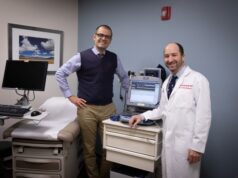Remote monitoring of implantable cardioverter defibrillators (ICD), particularly in cardiac resynchronisation therapy (CRT-D), reduces direct healthcare costs compared with standard monitoring, an economic evaluation of the results of the EFFECT trial has found.
The EFFECT study was a multicentre observational investigation of the clinical effectiveness of remote monitoring compared with in-office visits standard management.
The economic analysis, published by Alessandro Capucci (Cardiology and Arrhythmology Clinic, Universita Politecnica delle Marche, Ancona, Italy) and others in Europace, provides original data demonstrating that remote monitoring is associated with lower costs for the healthcare service in a real-world cohort of heart failure patients with ICDs, and shows remote monitoring of ICD is effective and produces savings, especially for patients who received CRT-D.
ICD and ICDs for CRT-D are effective therapies for patients with heart failure. These patients require admissions for disease management, and outpatient visits for disease management and assessment of device performance, which places a significant burden on health services. Remote monitoring technologies facilitate patient follow-up and provide an alternative to frequent hospital visits.

The EFFECT study is one of the largest observational studies conducted in Europe on the remote monitoring of patients affected by heart failure. It compared standard management by means of in-office visits with management through remote monitoring in patients with either ICD or CRT-D devices, in the clinical practice of 25 Italian centres. An economic analysis of the results of the EFFECT trial assessed the affordability of remote monitoring from the perspective of the Italian National Healthcare Service (NHS), considering the direct consumption of healthcare resources over 12-month follow-up.
Standard tariffs were applied to hospitalisations, in-office visits and remote device interrogations. Economic comparisons were also carried out by means of propensity score analysis to take into account the lack of randomisation in the study design. The analysis involved 858 patients with ICD or CRT-D. Of these, 401 (47%) were followed up via a standard monitoring approach, while 457 (53%) were assigned to remote monitoring.
The rate of hospitalisations was 0.27/year in the standard monitoring group and 0.16/year in the remote monitoring group (risk reduction=0.59; p =0.0004). In the non-adjusted analysis, the annual cost for each patient was €817 in the standard monitoring group and €604 in the remote monitoring group (p=0.014). Propensity score analysis, in which 292 remote monitoring patients were matched with 292 standard monitoring patients, confirmed the results of the non-adjusted analysis (€872 in the standard monitoring group versus €757 in the remote monitoring group; p<0.0001).
The authors concluded that remote monitoring is a cost-effective technology for heart failure patients following ICD implantation, both in terms of reduced resource consumption and clinical effectiveness.
They said: “The present analysis reinforced the evidence that remote monitoring is a good management strategy for heart failure patients in whom defibrillators are implanted. Indeed, better clinical outcomes are achieved with an economic advantage for the healthcare service. In particular, remote monitoring seems to result in lower costs in the CRT-D population—significantly lower costs were observed in the overall population and in the CRT-D subgroup, while direct costs were similar between groups in the ICD population. However, in none of the settings analysed was remote monitoring associated with an increase in healthcare costs.”
But they conceded that, although the results could be considered robust, there were some methodological limitations, the main one being a lack of randomisation. However, they said the propensity score matching used to overcome this issue confirmed the findings yielded by the unadjusted analysis.
“Our results obtained in the overall population showed a significant annual difference in healthcare costs between standard monitoring and remote monitoring strategies: €213 per patient in the unadjusted analysis and €115 in the propensity score adjusted analysis. This difference illustrates the economic benefit that the Italian NHS could obtain by adopting remote monitoring. In other words, if the Italian NHS invested up to €115/patient in managing patients by means of remote monitoring, this option would remain cost-saving versus standard monitoring, and more effective in terms of the reduction in the clinical burden of chronic heart failure.”









